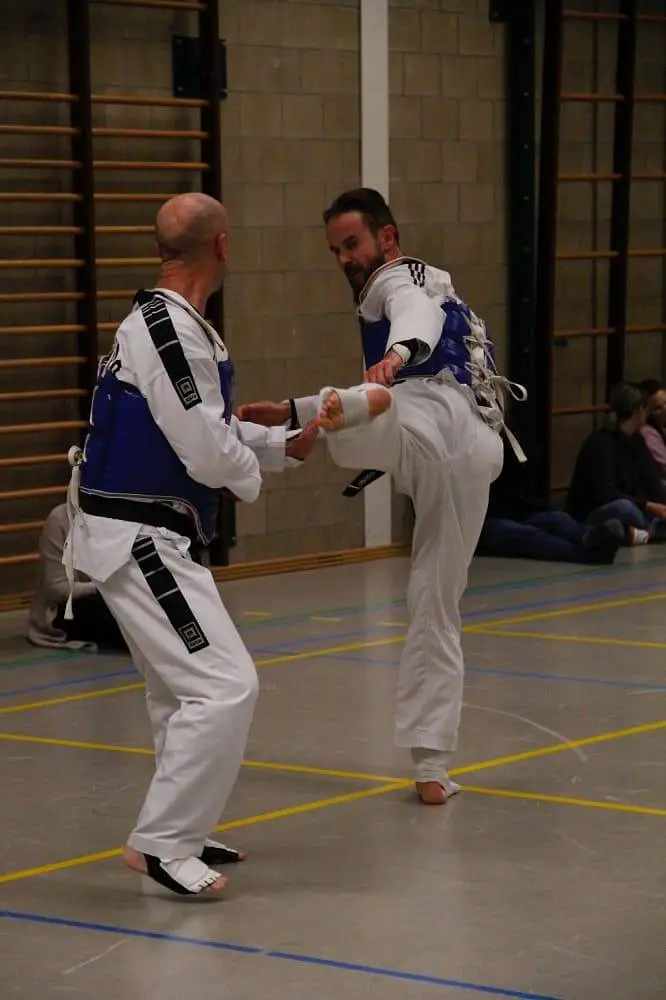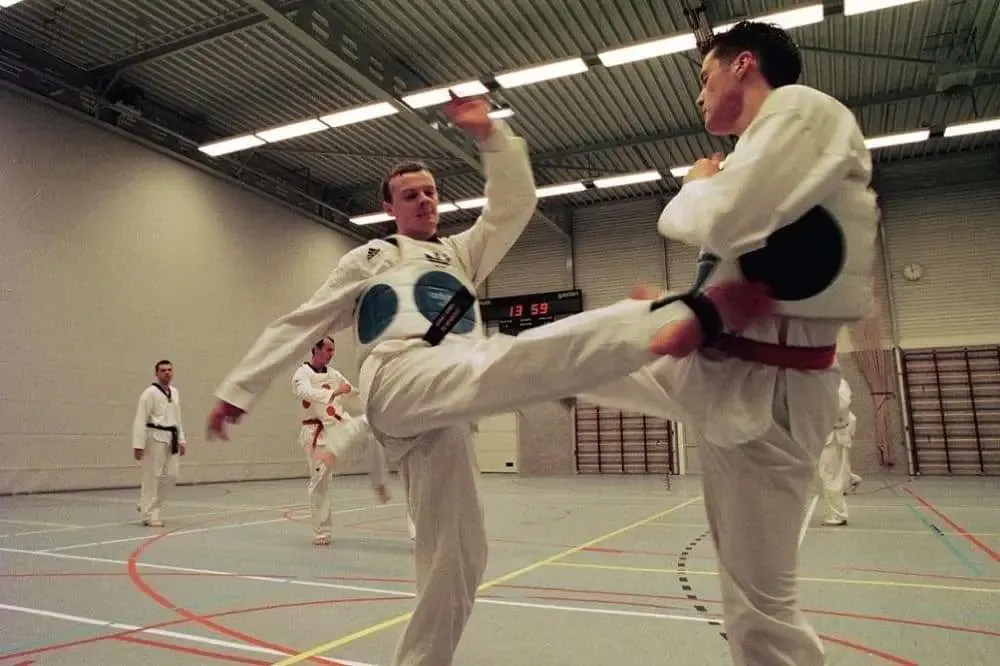Starting Taekwondo or any new sport can be very exciting but also frustrating at times. Getting the hang of the jargon, the techniques, and your training buddies is never super simple.
It takes time and effort, especially in the beginning. But there’re always tips and tricks you probably wouldn’t have known as a beginner, that would have improved the experience drastically!

Same applies to taekwondo, there are many ways to make training a lot easier and a bit more fun for yourself when starting out.
Here are my top 10 tips for beginners that will help ease you into the amazing sport that is taekwondo, and leave you wanting to go back for more!
Table of Contents
1. Find the Right Dojang
There are thousands of dojangs all over the world all with different priorities and training styles. Knowing what you want and what a dojang wants is the first step to successfully practicing Taekwondo.
Before we talk about the different aspects of a dojang, you should know what a bad dojang is. A bad dojang is one that encourages violence rather than self defense or sport. Other signs of a bad dojang include dirty facilities, and unsafe practices etc.
There are many different aspects of each dojang. Here’s a quick list: competitive vs casual, traditional vs new, sport vs self defense. Every dojang has a bit of all these, but they tend be more one than the other.
In addition to these aspects, some dojangs are very patriotic while others refrain from patriotism. It’s also important to mention that there are even religious dojangs for those who are interested.
Ask your teacher what kind of dojang they think theirs is before taking (or after taking) a class. It’s important to also ask yourself what kind of dojang you want (whether it is competitive, traditional or for self defense).
It might also take a couple of lessons to see what kind of dojang you want and that’s ok too!
2. Stretch Properly
This one might seem really obvious, but it’s important to note that stretching for Taekwondo is different than stretching for other sports like basketball for example.
When stretching for TKD, make sure to stretch mainly your legs particularly your hamstrings. An easy stretch for this muscle is to simply reach down and touch your toes while your legs are together.
One thing to remember here is that Taekwondo stretches should be done statically, without bouncing back and forth. Find how far you can stretch and hold it there for ten seconds for each set, you should do minimum of 2 sets.
Here’s a list of different stretches and what muscles they stretch:
Butterfly: Sit with the bottoms of your feet together and your knees out to your sides. To stretch, simply try to push your nose as close to your feet as possible. Muscle(s): Groin.
Chinese Splits: From standing, spread your legs out sideways as much as possible without bending your knees. Reach for your toes on one side then the other, and then try to touch the floor. Make sure to reach with both hands. Muscle(s): Groin, hamstring, hip flexors, and core.
American Splits: From standing, spread your legs with one foot forward and one back. Once again keep your knees straight. push your torso slightly forward, but do not reach for your toes. Muscle(s): Calves, core, and hamstring.
Hip Spins: Stand with your feet shoulder width apart, and have your hands on your hips. slowly roll your hips in a circle like you are hula hooping. Muscle(s): Hip flexors and core.
Make sure to stretch before and after a class/workout.
3. Take Things Slowly
This is a good advice for starting out in any sport, but particularly in Taekwondo. It’s important because of all the new ways your body will be moving (you don’t only kick everyday in taekwondo).
Do the warm up at 50% the first day, then work your way up to around 75%. Make sure you’re breathing (in through your nose, out through your mouth like a runner).
Approach new techniques with caution; a new kick done too quickly and improperly, can tear a muscle which will keep you off the mat for a week at least.
If you take your time to do each technique properly rather than quickly and powerfully at first, later on you won’t have to reteach your body how to do a proper sidekick or a roundhouse.
That being said, it’s ok if you don’t get it right away. Pivoting your foot while kicking is particularly difficult for beginners of Taekwondo, and usually takes at least a month to be put into practice.
4. Visualize before Doing
This is similar to my last point, but maybe even more important: visualize what you want your body to do before doing it.
This means you should carefully watch other students’ and the teacher’s example of how to do a technique and then imagine yourself doing it in that same exact way.
If you see someone doing a sliding sidekick their foot perfectly horizontal, their hands up, and the standing foot’s heel facing their target, think of yourself doing the same.
This also works with sparring particularly well. If you have trouble when sparring a particular partner (I don’t mean you’re losing because sparring at this level is not about losing but about practicing), visualize your next fight with them. Think about what they might do and how you might counter them.
5. Practice Forms at Home
Forms might seem laborious and ineffective ways of practicing techniques, but trust me, they are key to becoming a great martial artist.
At first when you practice a form, you need to be completely conscious of your every move. You must think them all through, making sure you aren’t forgetting anything. This means you are visualizing in a way unconsciously.
After around 10 times of practicing the moves, you will begin to do them unconsciously like a choreographed dance. This is both good and bad. The good part is you practice effortlessly without any hesitation. The bad part is any mistakes you are making will get cemented into your training.
Later down the line in your training, you will have to weed out certain mistakes. But for now, just practice and ask for feedback from your teacher or more advanced students when it comes to your forms.

6. Spar at 50%
As previously mentioned, sparring as a beginner is all about practice, not competition. Sparring is a great way to use the techniques you have been learning in real time with a real partner.
One thing to keep in mind; a sparring partner is not working against you but with you. They are a partner, not an opponent.
While sparring, don’t use all 100% of your effort. Try using 50% the first time, starting off slow, thinking through each kick and block.
When you get hit, always try to answer it with a kick, but if you are too tired or if you’re not in a good position, just shrug it off.
7. Be Light on Your Feet
This is an advice you will hear for any martial art. With Taekwondo, it is particularly important because of just how essential being quick is to the art form.
To be light on your feet, you need to try to put your weight on the balls of your feet (the front part just before the toes). From this part, your body can jump, slide, run, and kick super easily.
At first, it might be really tiring because bouncing on the balls of your feet works your calves like jumping rope.
A good tip here is when bouncing, make sure you’re not going too high, you don’t actually want your feet to leave the ground. You just don’t want your weight to be stagnate.
8. Kiai Every Kick
Kiai is a type of short shout/sound that tightens your body while doing a technique. Kiai also has many other purposes. They remind you to keep breathing, and they help your muscles relax (specifically after you kiai, your muscles relax).
They help put power into every kick you throw, but also take your forms from just being monotonous repetitions, to being crisp powerful shows of the art that is Taekwondo.
I should mention, only kiai in a form when you are told to. Do not kiai on every technique as it will be very annoying for both you and the audience.
9. Have Rest Days Between Workouts
This goes for any sport. After your first day working out, you will feel different muscles in your legs more acutely. These muscles will need time to rest and rebuild after each session.
Give yourself a rest day (maybe two for the first few weeks) between practice sessions.
On these rest days, try to stretch your legs at least once a day. Also try to eat well, not drink too much caffeine, and get enough sleep.
10. Socialize (Outside of Class)
Socialization makes a dojo work. Remember, you’re not practicing with a bunch of robots but other human beings with lives outside Taekwondo as well.
Not only does socialization help make the classes more lively and fun, it also helps make people comfortable in each other’s company, which in turn will help you train better and improve faster.
That being said, It doesn’t mean you have to be best friends with everyone there. But a bit of small talk goes a long way.
It’s important mention here, you shouldn’t socialize too much during the class either. It’s particularly rude to talk while exams are going on. It goes without saying, speaking over the teacher is inadmissible.
Get to know your fellow students and your teacher outside of class (before and after). Arrive ten minutes before the lesson starts. You will slowly become more and more a part of the dojo’s community.
To Wrap Things Up
Like I said in the beginning of the article, starting taekwondo or any other new sport can be difficult, and you should be proud yourself for being brave enough to try it.
The 10 taekwondo tips for beginners in this article should help you enjoy you training more, and more importantly rip all the amazing benefits taekwondo has to offer.